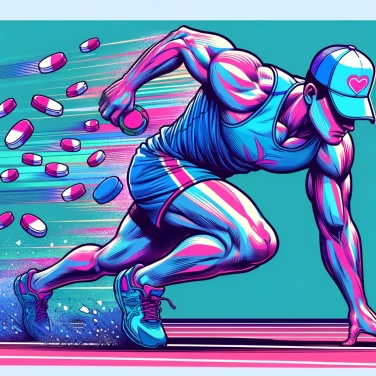Some athletes dope to improve their physical performances, increase their endurance or strength, enhance their recovery after exertion, or to boost their concentration during competitions.

Some athletes feel enormous pressure to succeed at all costs. In high-level sports, they are not only expected to participate but to win. Their coach, their team, their country: many expectations rest on their shoulders. In the face of this, failure is sometimes not an option, and some crack under the fear of disappointing, pushed to turn to doping to push their physical and psychological limits. Professional sports have become so competitive that every detail matters, and the difference between success and failure often comes down to very little. Thus, the temptation to resort to banned substances is strong, simply to hope to compete.
For some athletes, the difference between victory and merely making it to the finals can be very costly. An Olympic medal, a win in a major competition, or a world record can attract significant sponsors and lucrative advertising contracts. Not to mention the skyrocketing media attention, which is synonymous with appearances on TV shows, invitations to prestigious events, and other derived income. In short, sporting glory can quickly turn into a financial jackpot. Naturally, this opportunity to radically improve their lives drives some to cross the line of doping, willing to risk their careers and values to hit the jackpot or simply not miss the success train at all costs.
When an athlete sees their friends or competitors taking performance-enhancing substances, they may feel a sort of tacit obligation to do the same to stay in the race. No one wants to be left behind if others have found a way, even illegal, to boost their performance. Coaches or managers, by placing constant pressure on performance, often intensify this situation, indirectly pushing the athlete to cross the line. In certain sports environments, doping even becomes a kind of hidden norm, discreetly accepted by the entire group. As a result, collective influence sometimes makes it difficult to say no to these practices.
Society highly values champions: being the best grants a high social status and admiration. Some athletes will do anything to achieve this feeling of personal validation, willing to cross the red line to experience this glory. A doping athlete may feel they have finally reached a strong and recognized image, feeling socially accepted thanks to their victories. This recognition then provides an enormous boost to personal confidence, even if the reality behind it is distorted.
Although doping controls are frequent, they are unfortunately not infallible. Some athletes slip through the cracks because several substances can be taken in small doses or at specific times to be almost undetectable during a test. Moreover, new doping substances often emerge, and since tests take time to adapt, some athletes get a head start. There are also geographical areas where controls are less stringent, which encourages riskier practices. Finally, unannounced controls, which are normally essential and effective, are not always as frequent and unexpected as they should be, thereby opening a door to doping for some determined athletes.
Caffeine was part of the list of prohibited substances until 2004, but since that date, it has been removed from the list of doping products, although its consumption is still monitored by the World Anti-Doping Agency (WADA).
Some studies indicate that a placebo effect can sometimes enhance athletic performance simply because the athlete believes they have taken an effective substance, highlighting the psychological impact of doping.
The first officially recorded case of doping at the modern Olympic Games dates back to 1968, when Hans-Gunnar Liljenwall, a Swedish pentathlete, tested positive after consuming alcohol to calm his stress.
Surprising doping techniques exist, such as blood doping, in which the athlete artificially increases the number of red blood cells in their blood to significantly enhance the oxygen supply to their muscles.
Even though control procedures are constantly improving, some flaws still exist, such as the difficulty in detecting new substances or new doping methods, the limitations on the frequency of tests, and insufficient detection windows.
Sure! Here’s the translation: "Yes, some dietary supplements may contain banned substances without explicitly mentioning them on the label. Therefore, it is recommended to carefully check the composition and to use only certified supplements."
If you suspect a case of doping, it is important to inform sports authorities or an anti-doping organization. Some organizations allow you to report these suspicions anonymously so that tests can be conducted and the situation clarified.
Doping poses serious risks, such as cardiac, liver, renal, hormonal, and psychological problems. In the long term, it can even jeopardize the athlete's life.
Signs may include suddenly improved performance, rapid physical changes, alterations in mood or behavior, as well as an abnormally quick recovery after physical exertion.

0% of respondents passed this quiz completely!
Question 1/5